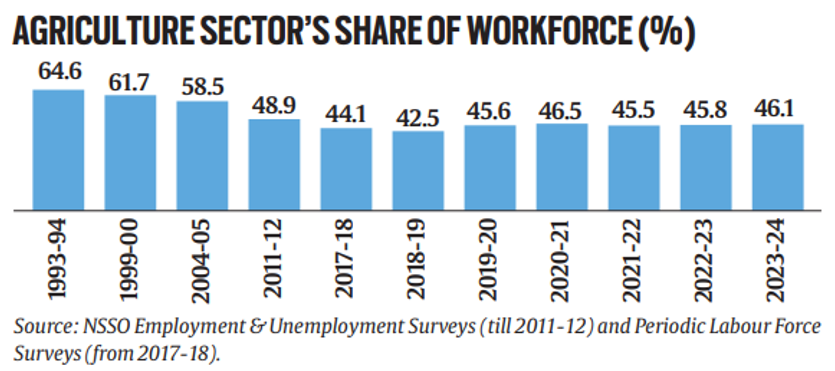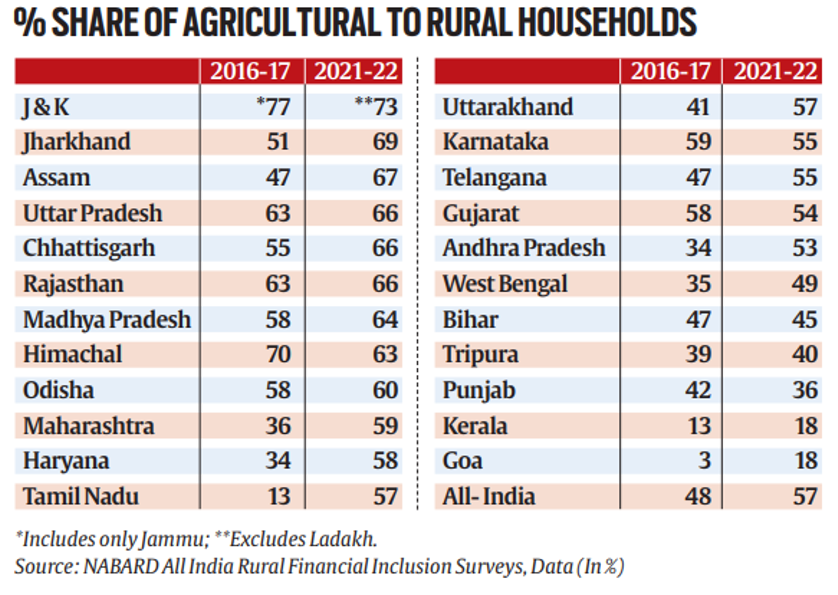Rising Reliance on Agriculture in Rural India Amid Economic Growth: A Post-Pandemic Paradox
(Source: Indian Express; Section: Explained; Page: 14)
| Topic: GS3 – Agriculture |
| Context: |
|
Analysis of News:
Rising Dependence on Farming in Rural India
- The recent NABARD All India Rural Financial Inclusion Survey (2021-22) reveals a growing reliance on farming for livelihoods. The proportion of rural households engaged in agriculture has increased from 48% in 2016-17 to 57% in 2021-22.
- This growth indicates a reversal of the trend where rural India was increasingly moving away from agriculture.
- Additionally, agricultural households now earn more monthly on average compared to non-agricultural households, signaling the rising income contribution from farming activities.
Shift in Income Sources for Agricultural Households
- Agricultural households have seen a higher share of their income come from farming-related activities like cultivation and animal husbandry.
- This increase is evident across various landholding sizes. The contribution of non-farming income sources has correspondingly decreased.
- This growing financial dependence on agriculture contradicts expectations of rural economies diversifying into other sectors.
Impact of COVID-19
- The pandemic played a crucial role in this shift. While most sectors faced significant disruptions, agriculture was exempted from lockdown restrictions.
- The farm sector remained stable, benefiting from consecutive good monsoons, and this resilience likely inflated agriculture’s share in rural livelihoods.
- Despite the recovery of the broader economy post-pandemic, agriculture’s role remains heightened.
The Paradox of India’s Economic Growth

- Despite India’s growing economy, the share of the rural workforce in agriculture remains elevated.
- Data from the Periodic Labour Force Surveys (PLFS) indicates a reversal in the decline of agriculture’s share in employment since 2018-19.
- The persistence of this trend, even amid GDP growth, raises questions about the lack of job creation in industries like manufacturing.
- Instead of transitioning to factory-based employment, surplus labor from agriculture has moved to sectors with similarly low productivity and wages, such as trade and construction.
Regional Variations

- The reliance on agriculture varies across states, with states like Chhattisgarh, Madhya Pradesh, and Uttar Pradesh having high agricultural employment, while states like Goa, Kerala, and Punjab report much lower shares.
- This disparity highlights regional differences in economic structure and opportunities beyond farming.
Conclusion
- India’s increasing dependence on agriculture for livelihoods, even as the economy expands, highlights a complex dynamic.
- The pandemic-induced shifts and limited job creation in other sectors may explain this paradox, underscoring the need for further policy focus on industrial growth and employment diversification.
| Practice Question: Examine the reasons behind the increasing dependence on agriculture for livelihoods in rural India post-pandemic, despite significant economic growth and diversification efforts. What implications does this trend have for rural development and employment generation? (250 words/15 m) |
